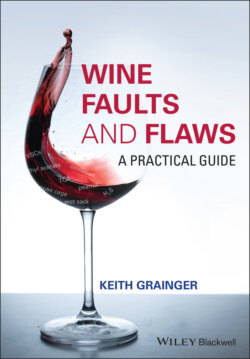Читать книгу Wine Faults and Flaws - Keith Grainger - Страница 54
2.5.3 Intensity
ОглавлениеThe intensity, i.e. the depth of colour, should be noted. As well as holding the glass at a 30° angle as discussed, the depth of colour can be observed by looking directly down into the wine in the glass that is standing on a white background, as illustrated in Figure 2.3.
Figure 2.3 Looking down to see depth of colour.
The intensity of wine can range from very pale to very deep. When writing a note, several steps between these extremes that might be detailed, e.g. medium‐deep. For novice tasters, it is perhaps useful to know that examining a standard tasting sample (3–4 cl) of a red wine, by holding the glass at 30° over a sheet of white paper containing printed type and the print is clearly visible, the wine may be described as pale or medium‐pale. If the print cannot be seen, then deep or very deep might be the appropriate descriptors.
Very often, wines that are pale in intensity will be lighter in flavours and body than those that are deep, but this is not always the case, and sometimes pale wines can often be overtly aromatic. Whites that have had extensive barrel ageing will have a greater visual intensity, although red wines may lose intensity after a long period in barrel. Some red grape varieties such as Merlot and Syrah (also known as Shiraz) can produce deep‐coloured wines, especially when from a hot climate, or made with small berries which have a high skin to pulp ratio, or low yielding vines. Conversely, several red grape varieties, including Pinot Noir and, to a lesser extent, Nebbiolo produce wines that are usually not deep‐coloured. However, there are some notable exceptions to this, e.g. some Pinot Noirs from New Zealand's Central Otago region. The extraction techniques used, and particularly pre‐fermentation maceration (cold soaking) if undertaken, impact upon the colour intensity. However, paleness in red wine, especially a young wine, is often indicative of a lack of concentration, which might be the consequence of many various factors such as a difficult growing season or inadequate extraction. Full‐bodied and concentrated reds, especially those from hot climates, will be deep or opaque in youth, and this suggests intense flavours and may be indicative of good quality. The colour intensity of red wines decreases with maturity, but the opposite is the case with aged whites. However, occasionally extremely deep‐coloured red wines can be surprisingly lacking in flavours. There are a few red varieties that have coloured flesh as well as black skins (e.g. Alicante Bouschet) but are surprisingly lightly flavoured. These teinturier grapes may, very occasionally, be used in a blend to deepen the colour of a wine that might be perceived as too pale.
Further, intense colours can sometimes indicate winemaking methods that have focused on colour, rather than flavour, extraction. Mindful of the association in the eyes of drinkers (and critics) of deep red wines and perceived high‐quality, winemakers can manipulate intensity, for example, by the addition of 8000 color or Mega Purple, concentrates made from grape skins and seeds. Thus, the taster is cautioned against drawing conclusions as to style or quality at this stage. However, a red wine that is paler than expected or white wine deeper than expected may be suffering from oxidation, which will be further evidenced by the colour, nose, and palate.
